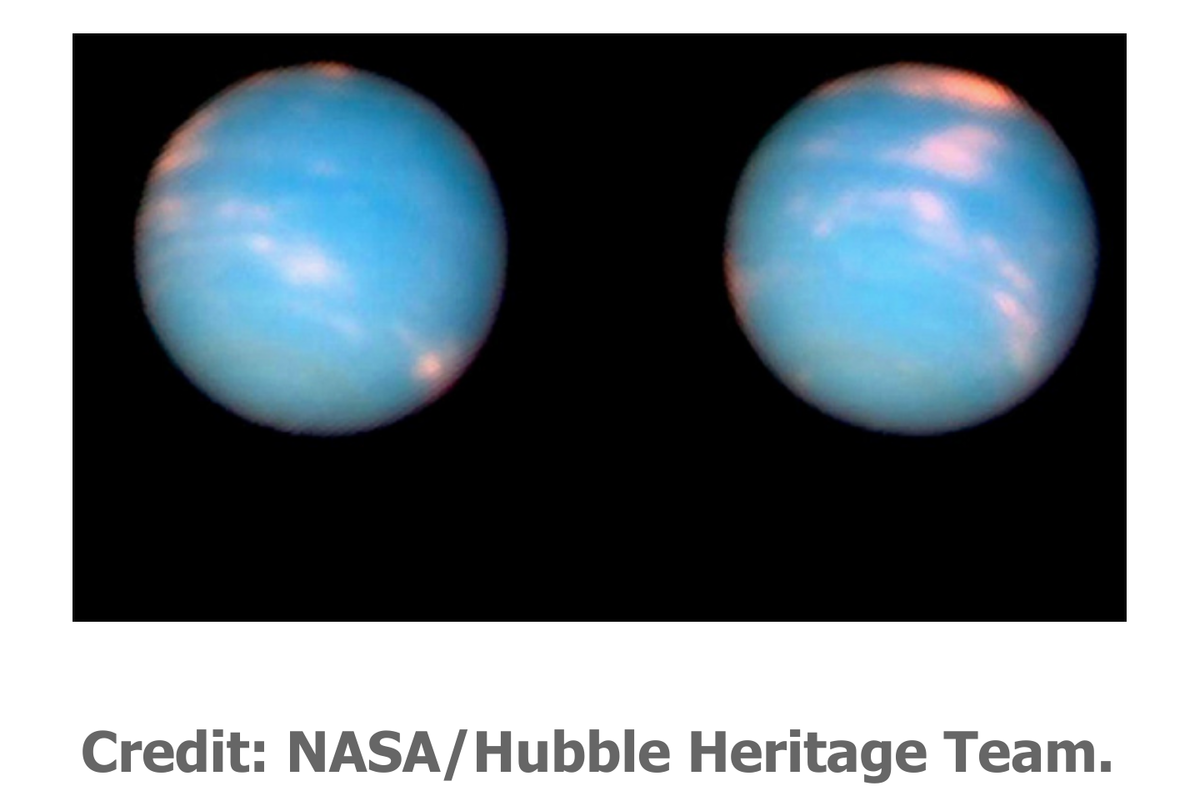[Poseidon Aegaeus ポセイドン・エガエウス]
Stephen Smith October 22, 2012 - 23:00Picture of the Day

Neptune’s clouds in false color.
偽色の海王星の雲。
――――――――
Oct 23, 2012
海王星は太陽系で最も遠い惑星です。 何がその異常な風を駆り立てますか?
木星の風は、平均時速約400キロメートル、大赤斑周辺の最速ストリーミングは時速635キロメートルです。
土星では、時速1800キロメートルまでの風速は、軌道を回るカッシーニ宇宙船によって計時されていますが、天王星のハッブル宇宙望遠鏡の観測は、時速900キロメートルで吹いている雲の帯を示しています。
〈https://www.thunderbolts.info/wp/2011/11/10/sturm-und-drang/〉
海王星では、窒素、酸素、アルゴンが凍結して固体になるほど寒い場所では、大暗斑の周りの風が時速約2000キロメートルで動いています。
〈https://nssdc.gsfc.nasa.gov/image/planetary/neptune/darkspot.jpg〉
従来の理論によれば、惑星風は対流によって引き起こされます:
暖かい空気の領域に流れ込む冷たい空気。
その対流は、太陽エネルギーがさまざまな大気領域を選択的に加熱し、ガスを上下させることによるものと考えられています。
太陽エネルギーが最も少ないこの惑星が最大の対流を経験するのはなぜですか?
たとえば、海王星では、太陽は地球で見られるよりも900倍暗いですが、私たちの惑星の平均風速は時速56キロメートルにすぎません。
最速の風は1997年12月17日に記録されました:
グアム島で時速378キロでした。
海王星の風速の開始者が、4.486 X 10 ^ 6キロメートル離れた直径49,500キロメートルの巨大ガス惑星を加熱している太陽であると推定されるのは非論理的です。
推定にはもっと驚きのようなものが必要なようです、宇宙の光のそのような小さなピンポイントを
—海王星の観点から見たら明るい1つの恒星にすぎません—
この大きな効果で刺激する為には。
海王星に関しては、コンセンサス天文学者と電気的宇宙の支持者の両方が不利です。
ボイジャー2号の宇宙船だけが、この凍った巨星を訪れ、ネプチューンの北極から4900キロメートル上にあるディープ・スペースと、時速62,000キロメートル近くでランデブーを飛行しました。
最近アップグレードされたハッブル宇宙望遠鏡は、ほんの数年しか海王星を観測していません。
海王星の季節(四季)は平均して約40年(165年の軌道と29度の傾斜に基づく)なので、天文学者は、その大気の変化に関するデータを収集する時間がほとんどありませんでした。
ウィスコンシン大学マディソン宇宙科学工学センターの上級科学者であり、海王星の大気の第一人者であるローレンスA.スロモフスキーからのコメントは、従来の見方への洞察を提供します。
ネプチューンは、「…ネプチューンの大気圏であるマシンを実行するために利用できるわずかな量のエネルギーしか持っていません。
それは、摩擦がほとんどなく、多くの天候を作り出すことができる、十分に潤滑されたマシンでなければなりません。」
大気対流から導出された厳密に流体力学モデルを使用してネプチューンを見る事は、太陽系のすべてのメンバーが浸っている電気的環境を無視しています。
従来の理論では、風を空気分子の動きと定義しています。
電気的宇宙理論はその考えに同意しますが、説明にはまだまだあります。
惑星大気中の静電放電は、太陽系全体で一般的です、おそらく海王星にも。
雷は電荷の分離を必要とするので、さまざまな密度と組成の雲の層が必要です。
海王星は、高高度のメタン雲、硫化水素-メタン層、および水と硫化水素アンモニウムの層をより深く示しています。
いわゆる「ホイッスラー(共鳴音)」が海王星の磁気圏で検出されていますが、雷を直接観測することはできていません。
風は、対流とガスの動力学にすぎないと想定されていますが、電気的宇宙の支持者達は、放電も風を生成すると主張します。
〈http://www.thunderbolts.info/tpod/2004/arch/040917electric-weather.htm〉
電磁力は、プラズマ中の荷電粒子を動かして加速し、そのため、中性の空気分子はそれらと一緒に引きずられます。
実験室のアーク放電は、電気の「風」が電気アークを取り囲み、しばしばそれに先行することを明らかにします。
海王星の大気中のプラズマ放電は、おそらく電荷キャリアまたはイオンとともに周囲の空気を一掃しています。
間違いなく、大なり小なり同じ現象がすべての惑星の大気で起こっています。
類推によって、太陽の熱だけによって生成された熱気の対流によって引き起こされている地球上の雷雨嵐の受け入れられた説明には疑問の余地があります。
スティーブン・スミス
――――――――
Oct 23, 2012
Neptune is the Solar System’s most remote planet. What drives its extraordinary winds?
海王星は太陽系で最も遠い惑星です。 何がその異常な風を駆り立てますか?
The winds on Jupiter average about 400 kilometers per hour, with the fastest streaming around the Great Red Spot at 635 kilometers per hour.
木星の風は、平均時速約400キロメートル、大赤斑周辺の最速ストリーミングは時速635キロメートルです。
On Saturn, wind speeds up to 1800 kilometers per hour have been clocked by the orbiting Cassini spacecraft, while Hubble Space Telescope observations of Uranus show the cloud bands blowing at 900 kilometers per hour.
土星では、時速1800キロメートルまでの風速は、軌道を回るカッシーニ宇宙船によって計時されていますが、天王星のハッブル宇宙望遠鏡の観測は、時速900キロメートルで吹いている雲の帯を示しています。
〈https://www.thunderbolts.info/wp/2011/11/10/sturm-und-drang/〉
On Neptune, a place so cold that nitrogen, oxygen, and argon could freeze into solids, winds around the Great Dark Spot are moving at almost 2000 kilometers per hour.
海王星では、窒素、酸素、アルゴンが凍結して固体になるほど寒い場所では、大暗斑の周りの風が時速約2000キロメートルで動いています。
〈https://nssdc.gsfc.nasa.gov/image/planetary/neptune/darkspot.jpg〉
According to conventional theories, planetary winds are caused by convection:
cold air flowing into regions of warm air.
従来の理論によれば、惑星風は対流によって引き起こされます:
暖かい空気の領域に流れ込む冷たい空気。
That convection is thought to be from solar energy selectively heating different atmospheric regions, causing gases to rise and fall.
その対流は、太陽エネルギーがさまざまな大気領域を選択的に加熱し、ガスを上下させることによるものと考えられています。
Why is it that the planets receiving the least solar energy experience the greatest convection?
太陽エネルギーが最も少ないこの惑星が最大の対流を経験するのはなぜですか?
On Neptune, for instance, the Sun is 900 times dimmer than seen on Earth, yet the average winds on our planet are a mere 56 kilometers per hour.
たとえば、海王星では、太陽は地球で見られるよりも900倍暗いですが、私たちの惑星の平均風速は時速56キロメートルにすぎません。
The fastest wind was recorded on December 17, 1997:
378 kilometers per hour on the island of Guam.
最速の風は1997年12月17日に記録されました:
グアム島で時速378キロでした。
It seems illogical that the initiator of Neptune’s wind speed is presumed to be the Sun heating a gas giant planet 49,500 kilometers in diameter from 4.486 X 10^6 kilometers away.
海王星の風速の開始者が、4.486 X 10 ^ 6キロメートル離れた直径49,500キロメートルの巨大ガス惑星を加熱している太陽であると推定されるのは非論理的です。
Presumption would seem to require something more like amazement that such a tiny pinpoint of light in space
—little more than a bright star from Neptune’s perspective—
could stimulate this large effect.
推定にはもっと驚きのようなものが必要なようです、宇宙の光のそのような小さなピンポイントを
—海王星の観点から見たら明るい1つの恒星にすぎません—
この大きな効果で刺激する為には。
Consensus astronomers and Electric Universe advocates are both at a disadvantage when it comes to Neptune.
海王星に関しては、コンセンサス天文学者と電気的宇宙の支持者の両方が不利です。
Only the Voyager 2 spacecraft has visited the frozen giant, flying by on its rendezvous with deep space at almost 62,000 kilometers per hour, 4900 kilometers above Neptune’s north pole.
ボイジャー2号の宇宙船だけが、この凍った巨星を訪れ、ネプチューンの北極から4900キロメートル上にあるディープ・スペースと、時速62,000キロメートル近くでランデブーを飛行しました。
The recently upgraded Hubble Space Telescope has been observing Neptune for only a few years.
最近アップグレードされたハッブル宇宙望遠鏡は、ほんの数年しか海王星を観測していません。
Since seasons on Neptune average around 40 years (based on its 165 year orbit and 29 degree inclination), astronomers have had little time to gather data about changes in its atmosphere.
海王星の季節(四季)は平均して約40年(165年の軌道と29度の傾斜に基づく)なので、天文学者は、その大気の変化に関するデータを収集する時間がほとんどありませんでした。
Comments from Lawrence A. Sromovsky, a senior scientist at University of Wisconsin, Madison’s Space Science and Engineering Center and a leading authority on Neptune’s atmosphere, provide an insight into the conventional view.
ウィスコンシン大学マディソン宇宙科学工学センターの上級科学者であり、海王星の大気の第一人者であるローレンスA.スロモフスキーからのコメントは、従来の見方への洞察を提供します。
Neptune possesses a “…trivial amount of energy available to run the machine that is Neptune’s atmosphere.
ネプチューンは、「…ネプチューンの大気圏であるマシンを実行するために利用できるわずかな量のエネルギーしか持っていません。
It must be a well-lubricated machine that can create a lot of weather with very little friction.”
それは、摩擦がほとんどなく、多くの天候を作り出すことができる、十分に潤滑されたマシンでなければなりません。」
Looking at Neptune using a strictly fluid dynamic model derived from atmospheric convection ignores the electrical environment in which all members of the Solar System are immersed.
大気対流から導出された厳密に流体力学モデルを使用してネプチューンを見る事は、太陽系のすべてのメンバーが浸っている電気的環境を無視しています。
Conventional theory defines wind as the movement of air molecules.
従来の理論では、風を空気分子の動きと定義しています。
The Electric Universe theory agrees with that idea, but there is more to the explanation.
電気的宇宙理論はその考えに同意しますが、説明にはまだまだあります。
Electrostatic discharges in planetary atmospheres are common throughout the Solar System, possibly on Neptune as well.
惑星大気中の静電放電は、太陽系全体で一般的です、おそらく海王星にも。
Since lightning requires the separation of electric charge, it requires cloud layers of varying density and composition.
雷は電荷の分離を必要とするので、さまざまな密度と組成の雲の層が必要です。
Neptune exhibits high-altitude methane clouds, a hydrogen sulfide-methane layer, and layers of water and ammonium hydrosulfide deeper down.
海王星は、高高度のメタン雲、硫化水素-メタン層、および水と硫化水素アンモニウムの層をより深く示しています。
So-called “whistlers” have been detected in Neptune’s magnetosphere, but no direct observation of lightning.
いわゆる「ホイッスラー(共鳴音)」が海王星の磁気圏で検出されていますが、雷を直接観測することはできていません。
If wind is supposed to be nothing more than convection and gas kinetics, Electric Universe proponents would insist that electric discharges also generate wind.
風は、対流とガスの動力学にすぎないと想定されていますが、電気的宇宙の支持者達は、放電も風を生成すると主張します。
〈http://www.thunderbolts.info/tpod/2004/arch/040917electric-weather.htm〉
Electromagnetic forces move and accelerate charged particles in plasma, so the neutral air molecules get dragged along with them.
電磁力は、プラズマ中の荷電粒子を動かして加速し、そのため、中性の空気分子はそれらと一緒に引きずられます。
Laboratory arc discharges reveal that an electric “wind” surrounds and often precedes an electric arc.
実験室のアーク放電は、電気の「風」が電気アークを取り囲み、しばしばそれに先行することを明らかにします。
Plasma discharges in Neptune’s atmosphere are probably sweeping up the surrounding air along with the charge carriers, or ions.
海王星の大気中のプラズマ放電は、おそらく電荷キャリアまたはイオンとともに周囲の空気を一掃しています。
No doubt the same phenomenon on a greater or lesser scale is happening in the atmosphere of every planet.
間違いなく、大なり小なり同じ現象がすべての惑星の大気で起こっています。
By analogy, the accepted explanation of thunderstorms on Earth being caused by the convection of hot air generated by the Sun’s heat alone is open to question.
類推によって、太陽の熱だけによって生成された熱気の対流によって引き起こされている地球上の雷雨嵐の受け入れられた説明には疑問の余地があります。
Stephen Smith
スティーブン・スミス